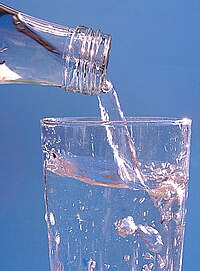
Photo from wikipedia
Up to now, only a few studies about microparticle contamination of bottled mineral water have been published. The smallest analysed particle size was 5 μm. However, due to toxicological reasons, especially… Click to show full abstract
Up to now, only a few studies about microparticle contamination of bottled mineral water have been published. The smallest analysed particle size was 5 μm. However, due to toxicological reasons, especially microparticles smaller than 1.5 μm are critically discussed. Therefore, in the present study, 32 samples of bottled mineral water were investigated for contamination by microplastics, pigment and additive particles. Due to the application of aluminium coated polycarbonate membrane filters and micro-Raman spectroscopy, a lowest analysed particle size of 1 μm was achieved. Microplastics were found in water from all bottle types: in single use and reusable bottles made of poly(ethylene terephthalate) (PET) as well as in glass bottles. The amount of microplastics in mineral water varied from 2649 ± 2857 per litre in single use PET bottles up to 6292 ± 10521 per litre in glass bottles. While in plastic bottles, the predominant polymer type was PET; in glass bottles various polymers such as polyethylene or styrene-butadiene-copolymer were found. Hence, besides the packaging itself, other contamination sources have to be considered. Pigment particles were detected in high amounts in reusable, paper labelled bottles (195047 ± 330810 pigment particles per litre in glass and 23594 ± 25518 pigment particles per litre in reusable paper labelled PET bottles). Pigment types found in water samples were the same as used for label printing, indicating the bottle cleaning process as possible contamination route. Furthermore, on average 708 ± 1024 particles per litre of the additive Tris(2,4-di-tert-butylphenyl)phosphite were found in reusable PET bottles. This additive might be leached out from the bottle material itself. Over 90% of the detected microplastics and pigment particles were smaller than 5 μm and thus not covered by previous studies. In summary, this is the first study reporting about microplastics, pigment and additive particles found in bottled mineral water samples with a smallest analysed particle size of 1 μm.
Journal Title: Water research
Year Published: 2018
Link to full text (if available)
Share on Social Media: Sign Up to like & get
recommendations!